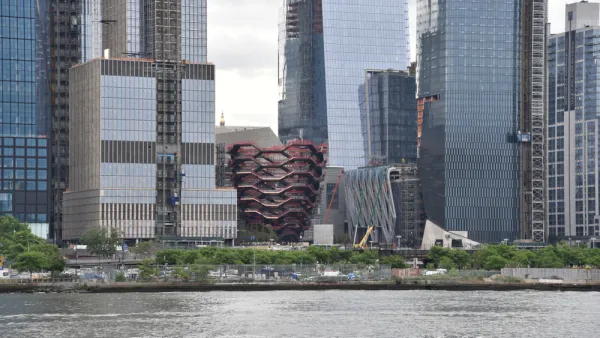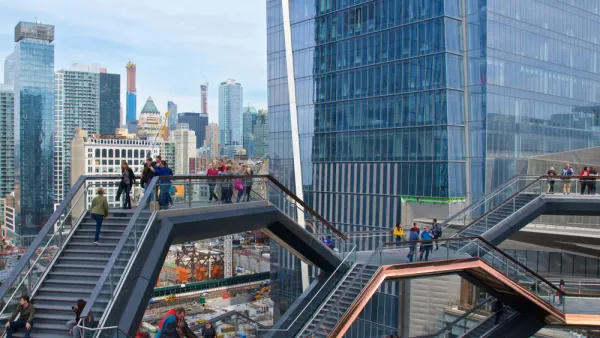The developers of Hudson Yards received $1.2 billion in financing from the EB-5 program, all made possible by a map that gerrymandered the project into the same neighborhood as Harlem public housing.

Kriston Capps reports on the financial deal that helped finance the Hudson Yards mega-project in New York City. Bolstering a point that heavily criticized design choices are not the component of the project most deserving our contempt. Capps explains that reasoning:
Without their knowledge, the residents of a number of public housing developments helped to make Hudson Yards possible. The mega-luxury of this mini-Dubai was financed in part through a program that was supposed to help alleviate urban poverty. Hudson Yards ate Harlem’s lunch."
Specifically, the project raised at least $1.2 billion of its financing through a controversial investor visa program known as EB-5. This program enables immigrants to secure visas in exchange for real estate investments. Foreigners who pump between $500,000 and $1 million into U.S. real estate projects can purchase visas for their families, making it a favorite for wealthy families abroad, namely in China. EB-5 is supposed to be a way to jumpstart investment in remote rural areas, or distressed urban ones.
Related Companies, the developer of Hudson Yards, "raked in" at least $1.2 billion in EB-5 funds for the project, despite the project being "nobody's idea of distressed."
So how did Related Companies manage to qualify for the project? A highly gerrymandered map, created by Empire State Development, the economic development agency for the state of New York.
New York state “gerrymandered” a map to qualify Hudson Yards for $1.6 billion in financing meant for low-income areas—by threading it to public housing in Harlem. @kristoncapps reports:https://t.co/71yXG5KqIl pic.twitter.com/gX3PrCHlex
— CityLab (@CityLab) April 21, 2019
As note by Capps, the Hudson Yards project is one symptom of larger problems with the EB-5 program, and not just an example of systematic failures of New York real estate.
Sophie Kasakove provides additional follow-up coverage of Capps's reporting, tying the EB-5 story of Hudson Yards to controversies created by the use of tax increment financing in Chicago.
FULL STORY: The Hidden Horror of Hudson Yards Is How It Was Financed

National Parks Layoffs Will Cause Communities to Lose Billions
Thousands of essential park workers were laid off this week, just before the busy spring break season.

Retro-silient?: America’s First “Eco-burb,” The Woodlands Turns 50
A master-planned community north of Houston offers lessons on green infrastructure and resilient design, but falls short of its founder’s lofty affordability and walkability goals.

Delivering for America Plan Will Downgrade Mail Service in at Least 49.5 Percent of Zip Codes
Republican and Democrat lawmakers criticize the plan for its disproportionate negative impact on rural communities.

Test News Post 1
This is a summary

Test News Headline 46
Test for the image on the front page.

Balancing Bombs and Butterflies: How the National Guard Protects a Rare Species
The National Guard at Fort Indiantown Gap uses GIS technology and land management strategies to balance military training with conservation efforts, ensuring the survival of the rare eastern regal fritillary butterfly.
Urban Design for Planners 1: Software Tools
This six-course series explores essential urban design concepts using open source software and equips planners with the tools they need to participate fully in the urban design process.
Planning for Universal Design
Learn the tools for implementing Universal Design in planning regulations.
EMC Planning Group, Inc.
Planetizen
Planetizen
Mpact (formerly Rail~Volution)
Great Falls Development Authority, Inc.
HUDs Office of Policy Development and Research
NYU Wagner Graduate School of Public Service





























